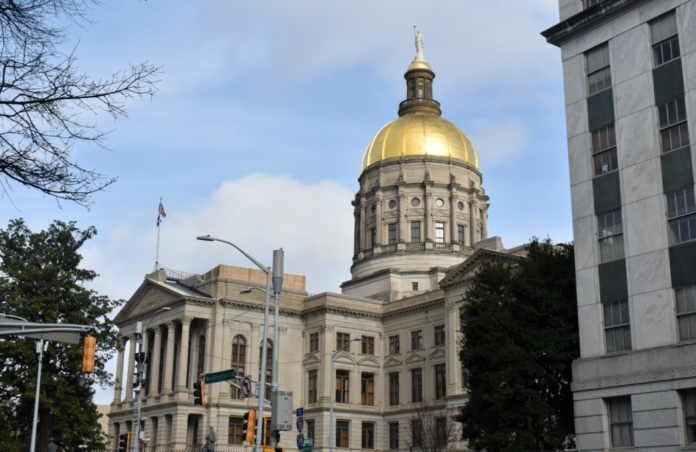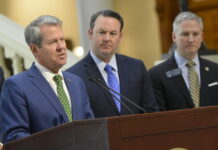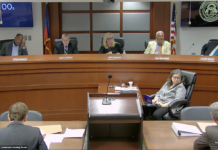
(Georgia Recorder) — Some of the most important legislative debates at the Georgia Capitol don’t take place under the Gold Dome, but are instead hashed out across Mitchell Street, where committee rooms are often packed with lobbyists and concerned members of the public.
It’s also the building where many lawmakers are assigned offices. And now the decades-old building is getting a replacement.
The Georgia General Assembly approved a $392 million project to build a new legislative office building, of which about $83 million will go toward renovating Georgia’s Capitol building.
The new legislative office building will loom eight stories over Martin Luther King Jr. Dr. SW, just across the street on the north side of the Capitol. Once operational, this building will replace the current Coverdell Legislative Office Building, or CLOB.
The legislative office building was first constructed in 1939 to serve as a federal office building but underwent extensive renovation in the 1980s to transition the site from a health building into an operating space for Georgia’s lawmakers. Now, some 40 years post updates, many lawmakers find that the 85-year-old structure is not up to par with their needs. The building was most recently named in honor of the late Paul Coverdell, a former GOP state and U.S. senator from the 1970s through the late 1990s.
“I know that some of the meeting rooms aren’t ideal,” said Rep. Matt Hatchett, a Dublin Republican and chairman of the House Appropriations Committee. “Some of them aren’t large enough, then you’ve got columns in the middle, and you can’t always see everybody in there … A lot of the infrastructure … it wasn’t built for what it’s being used for.”
In addition to the new legislative offices, the iconic Capitol will receive some attention in these renovations, both internally and externally. The gilded dome itself will receive a fresh layer of its recognizable gold coating, keeping the Georgia capital city’s skyline bright and sparkling. Previous changes to the Capitol will actually be undone in the upcoming project; markedly, a once lofty library that was waffled into office space is being promised restoration to its original purpose.
Although perhaps less of an upgrade to what meets the eye, other vital updates include advancements to outdated fire safety and the heating and air conditioning systems, as well as changes to address problems with accessibility.
Sen. Donzella James, an Atlanta Democrat and chairman of the Committee on Urban Affairs, has coped with a lack of accessibility inside the Capitol. Due to mobility issues, she often must use a wheelchair or other aid to navigate comfortably and safely.
“I have an office, 121, and it has a ramp to go up, but I can’t take a scooter up or a wheelchair or my walker because the ramp is not ADA accessible; it’s very steep,” James said. “And that way too, people who come and visit us who have the same type of issues or worse than mine can’t come into that suite either.”
The Georgia Council of Developmental Disabilities is not involved in the upcoming renovations, but Executive Director D’Arcy Robb spends plenty of time on Capitol Hill and has seen disabled individuals struggle to maneuver the government building in its current layout.
“Not all of the meeting rooms and not all the offices are accessible; the most probably blatant example is there is a meeting room that is only accessible via stairs,” Robb said. “It was unfortunate during session this year; one of the committee hearings on one of the bills that we were the lead technical advisors on, which was the state as Model Employer, the committee that heard that bill meets in that room. And so one of my staff was unable to attend just because he is a wheelchair user, and there is no way for someone who uses a chair to access that room.”
In the January 2024 Capitol/CLOB Space Utilization Assessment that developed the overhaul, solving accessibility shortcomings are a named project objective along with life safety, security and ventilation. However, not everyone is greeting the plan with excitement and appreciation. One of the most controversial components of this undertaking is the plan to connect the new legislative office building to the Gold Dome with a skybridge.
The skybridge will rise above Martin Luther King Jr. Dr., allowing vehicle traffic to continue unimpeded by pedestrians crossing the street below. The Space Utilization Assessment proposed two other options before settling on the bridge: a crosswalk and an underground tunnel. The bridge is the current planned connection between the two structures, but some preservationists are opposed to this – just as they have been in the past.
“In 1983, a plan was put forth to run a bridge from the second story of the legislative office building across into one of the windows, connecting through one of the window spaces on the exterior of the Capitol and into the Capitol,” said Timothy Crimmins, emeritus professor of history at Georgia State University.
The Atlanta Preservation Center is the city’s oldest nonprofit organization dedicated to preserving the city’s history. In the 1980s, the center opposed a sky bridge plan that faced enough backlash to be nixed, albeit temporarily, and the organization remains opposed to this plan today.
A tunnel is the center’s preference, said Executive Director David Mitchell.
“A transparent walkway connecting a historic building and a modern construction will be very challenging optically to understand, whereas an underground component provides you arguably much more mobility, much more opportunity,” Mitchell said. “And I’m sure there are challenges that exist because of water, electric, power, gas lines, ethernet, everything. However, it would, for me, be tragically unattractive, arguably inappropriate and most likely disturb the look and feel of our capital.”
The Georgia Building Authority manages and oversees governmental structures in the Atlanta area, primarily those on Capitol Hill. This makes it the spearhead of any new construction or renovation efforts. Gerald Pilgrim, deputy executive director and chief of staff, is aware of this opposition.
“We are looking at a couple of different options, but one of the things we want to do is make sure we keep the historical integrity and be able to restore the Capitol to the fullest extent,” Pilgrim said. “We’re looking at that with our historical preservationists and architects. So anything we do, be it through a bridge or if it’s connected with a tunnel, will be in keeping with historical integrity of the building.”
According to Pilgrim, the regilding of the Gold Dome is already underway, with the scaffolding beginning to be placed this week. Internal Capitol renovations will operate around when the General Assembly is in session for the next two years. The new Legislative Office Building is on track to be completed by November 2026, and all Capitol Hill renovations should be completed by the end of 2027.







